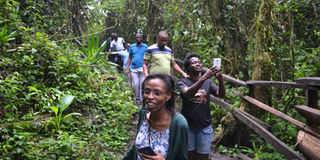Amabere ga Nyinamwiru and chilly waterfalls

What you need to know:
Beauty. Uganda has as much beauty as anyone could imagine about the Pearl of Africa. Roland D. Nasasira shares his maiden experience at Amabere ga Nyinamwiru in Kabarole district.
The closest I had ever been to Amabere ga Nyinamwiru caves and waterfalls was during Social Studies and Geography classes in school. These classroom lessons only gave me an understanding of where these physical features were without setting foot there.
However recently, Steadfast Safaris under the theme Knowing My Country afforded us a chance of visiting the place to interact with these features in Kabarole District in western Uganda. It is approximately 15 kilometres from Fort Portal town on Bundibugyo Road.
The experience
When we arrived, all we did was admire God’s creation. The walkway to the Amabere caves and falls lies between a thick green vegetation, between tall trees and vegetation, whose branches at some point touched our heads but it was guarded by wood rails to prevent it from falling. The slippery walkway led us on as we heard the whispers of the waterfalls.
Showers in the waterfalls
A bath at Amabere waterfalls is one that will leave you yearning for more. The coldness of the crystal clear water at the falls can be equated to water that has been kept in the fridge for some time.
When you step on the shores where the falls pour, it is shallow but the further you go, the deeper it becomes. It can cover someone of an average height up to the stomach. However, you cannot stay in that water for more than 20 minutes. The cold is unbearable, I imagine that, one can only swim or play in the water for about 20 minutes as you get back to the mainland or climb the surrounding rocks to sunbathe.
Mini geography class
Latif Muhumuza, a tour guide at the Amabere ga Nyinamwiru caves and falls, says these features are geographically termed as stalactites and stalagmites. The stalactites are those that hang on the ceiling of the caves while the stalagmites are the banana-like sharp pointed features that grow from the bottom of the caves, advancing one inch every year, with white coats.
“The water from the falls contains calcium carbonate of which the carbon dioxide from the atmosphere dissolves in the rock to mix with water,” Muhumuza says.
“The water continuously flows through the porous rock and then drops down to form the stalagmites where carbondioxide gas evaporates to leave calcium forming the stalagmites. That is why there is a white coat on the stalagmites that form an inch every year until they join to form a strong rocky pillar which supports the cave from collapsing,” he adds.
This too, explains why there is a walkway under the curvy rock that allows you to cross to one side of the falls without getting wet.
However, for the stalagmites and the stalactites to advance in growth, they need enough water to carry out the natural process. This, Muhumza noted is why there are active and inactive caves.
The active caves are those where there is growth of stalactites and stalagmites due to sufficient water and the inactive caves are those where there is no growth or advancement of stalactites and stalagmites due to insufficient water supply.
The Amabere ga Nyinamwiru water caves have two sources; the flat and wide Kamutebi swamp, which is in the neighbourhood of the caves and can be viewed from atop Kyegangwa hill, and the glacial water from the Rwenzori ranges.
Return
After the lesson, my colleagues opted to stay for photo moments and others walked back to our place of abode.
Give me Amabare ga Nyinamwiru any time.
Myth
The Amabere Caves (Nyakasura Caves) is not that much a caves, more a large overhang. The name Amabere Ga Nyina Mwiru translates as “Breasts of Nyinamwiru”, Nyinamwiru being the daughter of a local usurper king who reportedly had her breasts cut off to make her less attractive to men.
This rather drastic plan failed and the king, Bukuku of Toro then hid her in the cave. However with her allure still strong she became pregnant to the Batembuzi King Isaza and later gave birth to their son, Ndahura. Unable to breastfeed the infant herself she used what looked like milk dripping from the stalactites, which appeared milky because of its calcium content. - Internet




